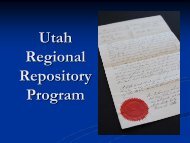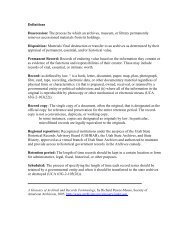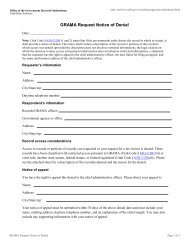electronic records management/ migration - Utah State Archives
electronic records management/ migration - Utah State Archives
electronic records management/ migration - Utah State Archives
You also want an ePaper? Increase the reach of your titles
YUMPU automatically turns print PDFs into web optimized ePapers that Google loves.
ELECTRONIC RECORDS<br />
MANAGEMENT/<br />
MIGRATION<br />
A Guideline of the <strong>Utah</strong> <strong>State</strong> <strong>Archives</strong> and Records Service<br />
System design considerations adapted from Arizona <strong>State</strong> Library, <strong>Archives</strong>, and Public Records, System Design<br />
Considerations<br />
June 2012<br />
Purpose:<br />
The Government Records Access and Management Act (<strong>Utah</strong> Code, Title<br />
63G, Chapter 2) and the Public Records Management Act (<strong>Utah</strong> Code, Title<br />
63A, Chapter 12) impose obligations to retain, manage, and provide access<br />
to state government <strong>records</strong> for the duration of their legal retention periods.<br />
In order to meet these requirements, recordkeeping practices need to be<br />
integrated into systems.<br />
The core requirements for managing <strong>records</strong> in an <strong>electronic</strong> environment are:<br />
Accessibility—the <strong>records</strong> must be available for appropriate use for the duration of the<br />
retention period.<br />
Authenticity—the <strong>records</strong> must be what they claim to be and have integrity, that is, have<br />
not been changed, deleted, or otherwise altered.<br />
Reliability—the data within the <strong>records</strong> is at all times retrievable (i.e., no loss of data).<br />
Secure—all of the people authorized to access <strong>records</strong> according to the classification of the<br />
<strong>records</strong>, and only those people, should have access.<br />
In addition, the systems must be trustworthy, with the hardware, software, and processes to<br />
manage the <strong>electronic</strong> <strong>records</strong> reasonably secure from misuse and intrusion.<br />
It is important to build <strong>records</strong> <strong>management</strong> into systems. The involvement of the <strong>records</strong> officer<br />
in the design of systems is essential to ensure that <strong>records</strong> meet legal mandates. Records officers<br />
should work with their IT professionals to ensure that systems can capture and maintain <strong>records</strong>,<br />
store <strong>records</strong> securely, provide access to those who are authorized, preserve essential and historical<br />
<strong>records</strong> and destroy obsolete <strong>records</strong> when they have met their legal retention period.<br />
Systems with no record <strong>management</strong> requirements put at risk valuable <strong>records</strong> that protect the<br />
rights of citizens, provide evidence of government accountability and document specific and<br />
significant government historical events. Not incorporating recordkeeping requirements has<br />
allowed <strong>records</strong> that need to be destroyed to be kept longer than required. The cost of managing<br />
346 S Rio Grande St • Salt Lake City, <strong>Utah</strong> 84101<br />
Telephone (801) 531-3848 • Facsimile (801) 531-3854 • archives.utah.gov
A Guideline of the <strong>Utah</strong> <strong>State</strong> <strong>Archives</strong> and Records Service<br />
and storing these <strong>records</strong> places an unnecessary financial burden on valuable and scarce public<br />
funds as well as adding liability in increased exposure in litigation.<br />
SYSTEM CONSIDERATIONS<br />
Here are some recordkeeping requirements to consider when developing a system:<br />
1. What <strong>records</strong> need to be created or kept that document the agency’s functions/activities in<br />
the system:<br />
a. What is necessary to capture?<br />
b. Who will rely on the information?<br />
c. Will it be necessary to provide a fixed record of what was relied on to make<br />
decisions by the agency?<br />
d. Will it be necessary to provide a fixed record of what was relied on to make<br />
decisions by the agency’s stakeholders or the general public?<br />
e. How will the information be verified for authenticity, completeness and accuracy<br />
before it is captured into a fixed record?<br />
f. Is an outside contractor being used [e.g., to receive inputs from stakeholders that are<br />
then converted to be ingested into the system], if so:<br />
i. Will inputs need to be captured as received from the stakeholders?<br />
ii. How will the information be verified for authenticity, completeness and<br />
accuracy before it is captured into a fixed record?<br />
iii. How long will <strong>records</strong> being received and created by the contractor need to<br />
iv.<br />
be maintained and accessible?<br />
All recordkeeping requirements should be documented in the contract with<br />
the contractor.<br />
2. What will be required to supply appropriate content, context and structure of the <strong>records</strong><br />
before the <strong>records</strong> are captured in a fixed method:<br />
a. Are there automated tools that can be integrated to provide date of creation/receipt;<br />
owner; classification information as the type of record [draft, version #, final<br />
official record, duplicate copy], <strong>records</strong> series [to be able to link the <strong>records</strong> to their<br />
retention periods and to other salient <strong>records</strong> related to the same business activity],<br />
and access restrictions [including the ability to redact restricted information from<br />
the <strong>records</strong> when required by an open <strong>records</strong> request]; and other metadata that will<br />
enhance the retrievability of the <strong>records</strong> [such as appropriate and approved<br />
keywords found in the agency’s official thesaurus]?<br />
b. What will be necessary to ensure a smooth transition when the <strong>records</strong> are migrated<br />
to another system?<br />
3. How will these <strong>records</strong> be captured so they are fixed?<br />
4. If retention periods for the <strong>records</strong> change, how will the new retention period be<br />
transitioned into the system?<br />
5. What is the business practice module that will create rules for the <strong>management</strong> of other<br />
data:<br />
a. Are specific data fields utilized by more than one business process requiring control<br />
by more than one retention period?<br />
6. How will <strong>records</strong> be maintained through the retention period:<br />
Electronic Records Management/<br />
Migration Guidelines 2 June 2012
A Guideline of the <strong>Utah</strong> <strong>State</strong> <strong>Archives</strong> and Records Service<br />
a. How will the <strong>records</strong> be protected from unauthorized access?<br />
b. How will the <strong>records</strong> be maintained to provide authorized access:<br />
i. How will copies be provided in response to open <strong>records</strong> requests?<br />
ii.<br />
How can sensitive data within the <strong>records</strong> be protected or redacted if<br />
needed?<br />
c. How will the <strong>records</strong> be protected from unauthorized destruction?<br />
d. If there are plans to move <strong>records</strong> near-line or off-line, what protocols will be built<br />
in to ensure that the media is refreshed and the bit error rate is corrected on a<br />
regular basis?<br />
e. What indexing systems will be used to ensure the <strong>records</strong> are accessible?<br />
f. What <strong>migration</strong> strategies will be in place to regularly replace the media and to<br />
refresh the data?<br />
g. What <strong>migration</strong> strategies will be used to convert the <strong>records</strong> without loss or<br />
corruption to the next version or another system?<br />
h. What will be the backup strategy used for the system:<br />
i. How will the strategy provide business continuity/vital <strong>records</strong> protection?<br />
ii.<br />
iii.<br />
iv.<br />
How will the strategy provide for the reliability and integrity of the <strong>records</strong><br />
should a server crash or if a security violation occurs?<br />
How will the strategy provide for times when the system is down:<br />
1. How will the <strong>records</strong> be available?<br />
2. How will new <strong>records</strong> be captured?<br />
3. How will captured <strong>records</strong> be put into the system after it is back up<br />
and running?<br />
How will the strategy provide for the deletion of <strong>records</strong> once their retention<br />
period has lapsed, even on backup media?<br />
i. What <strong>records</strong> will need to be created for audit purposes within the system:<br />
i. Will the system need to record who captured, retrieved or deleted <strong>records</strong><br />
and when?<br />
ii.<br />
Will the system ensure the appropriate metadata is maintained with the<br />
<strong>records</strong> for the entire length of the retention period?<br />
7. How will any downloads of data be managed so that renegade standalone systems are not<br />
created without the proper recordkeeping requirements attached to them?<br />
8. How will <strong>records</strong> be deleted from the system when their retention period has lapsed:<br />
a. How will the agency ensure that deletion does not impact other <strong>records</strong> that should<br />
be retained?<br />
b. Will the agency want to delete all associated metadata when the <strong>records</strong> are deleted,<br />
if not, what will need to be retained and for how long?<br />
9. How will <strong>records</strong> be protected from deletion when there is a hold on destruction?<br />
10. How will the <strong>records</strong> with permanent retention be preserved and accessible over time:<br />
a. How will permanent <strong>records</strong> be transferred to the <strong>State</strong> <strong>Archives</strong> in a way that<br />
documents the data structure?<br />
11. What system documentation will need to be created to document recordkeeping processes?<br />
Electronic Records Management/<br />
Migration Guidelines 3 June 2012
A Guideline of the <strong>Utah</strong> <strong>State</strong> <strong>Archives</strong> and Records Service<br />
12. What training will be provided to users to ensure they are aware of their recordkeeping<br />
responsibilities? 1<br />
FURTHER CONSIDERATIONS<br />
Many technological options already exist that can be utilized and/or integrated into systems. These<br />
options adhere to recordkeeping standards and can save the expense of developing new tools. The<br />
<strong>Utah</strong> <strong>State</strong> <strong>Archives</strong> can provide guidance on these tools. 2<br />
1 System design considerations adapted from Arizona <strong>State</strong> Library, <strong>Archives</strong>, and Public Records, System Design<br />
Considerations, http://www.lib.az.us/<strong>records</strong>/GuidanceAndRelatedResources/systems_design_consideration.aspx.<br />
2 See: <strong>Utah</strong> <strong>State</strong> <strong>Archives</strong>, Electronic Records Management Business Case, 2008,<br />
http://archives.utah.gov/<strong>records</strong><strong>management</strong>/ERM/ERMBusinessCase.pdf.<br />
Electronic Records Management/<br />
Migration Guidelines 4 June 2012








